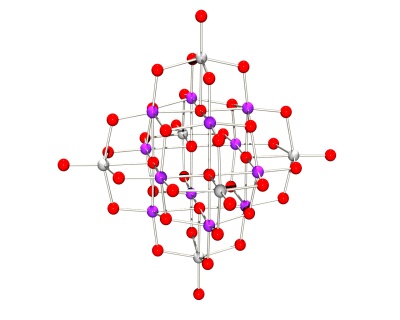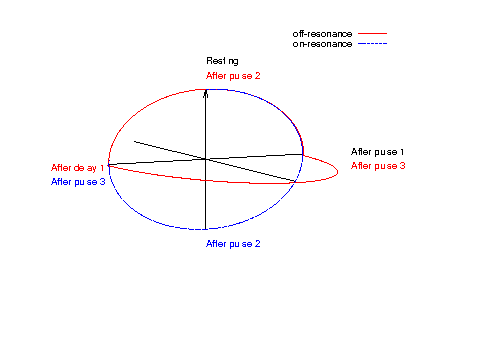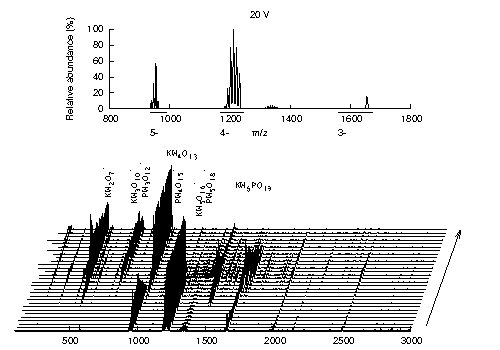Polyoxoniobates
The polyoxoniobates are different from the polyoxovanadates, -molybdates and -tungstates in that they typically are unstable at low pH, while showing good stability under more alkaline conditions. In addition, they are often more tolerant towards reducing conditions, suggesting their use as electron sinks, since they will seek to stay in or return to their higher oxidation states. Owing to the few groups involved in the niobate field, few homoleptic polyoxoniobates are known, and their use as ligands is almost completely unexplored

Figure: the 'super'-Lindqvist ion [Ti12Nb6O44]10-.
See e.g.
* Ohlin, C. André; Villa, Eric M.; Fettinger, James C.; Casey, William H. "The first peroxotitanoniobate cluster - [N(CH3)4]10[Ti12Nb6O38(O2)6]", Inorg. Chim. Acta, 2010, 363(15) 4405-4407. Link
* Ohlin, C. André; Villa, Eric M.; Fettinger, J. C.; Casey, William H. "A new titanoniobate ion - Completing the series [Nb10O28]6-, [TiNb9O28]7- and [Ti2Nb8O28]8-", Dalton Trans. 2009, 2677-2678. Link.
* Ohlin, C. André; Villa, Eric M.; Fettinger, J. C.; Casey, William H. "A new type of polyoxometalate - the [Ti12Nb6O44]10- ion" Angew. Chem. Int. Ed., 2008 , 47(30), 5634-5636. Link
NMR
NMR is typically taught with an eye towards its application towards characterization of organic compounds. However, it is also an enormously powerful tool for the investigation of dynamic processes in solution. A classical treatment of exchange phenomena allows for the design and interpretation of one- or two-pulse experiments for the determination of ligand exchange on both diamagnetic and paramagnetic metals by line-broadening and saturation-transfer techniques

Figure: Saturation transfer between two species separated by only a few ppm - the pulse sequence consists of pi/2, precession, pi/2, mixing, pi/2, observation
See e.g.
* Ohlin, C. André; Harley, Stephen J.; McAlpin, J. Gregory; Hockin, Rosalie K.; Mercado, Brandon Q., Johnson, Rene L.; Villa, Eric M.; Fidler, Mary Kate; Olmstead, Marilyn M.; Spiccia, Leone; Britt, R. David; Casey, William H. "Rates of water exchange for two cobalt(II) heteropolyoxotungstate compounds in aqueous solution", Eur. J. Chem. , 2011, 17(16), 4408-4417. Link
* Harley, Stephen J.; Ohlin, C. André; Johnson, Rene L.; Panasci, Adele; Casey, William H. "The pressure dependence of oxygen-isotope-exchange rates between solution and apical oxygens on the UO2(OH)42- ion.", Angew. Chem. Int. Ed. , 2011, 50(19), 4467-4469. Link
* Harley, Stephen J.; Ohlin, C. André; Casey, William H. "Geochemical kinetics via the Swift-Connick equations and solution NMR", Geochim. Cosmochim. Acta , 2011,75(13), 3711-3725. Link
Mass spectrometry
NMR typically requires suitable nuclei to be present in the analyte in order to do kinetic experiments. Mass spectrometry makes other requirements, but often constitutes a powerful technique for the characterisation of novel compounds and the investigation of their chemistries.

Figure: Stacked spectra obtained as a function of cone voltage.
See e.g.
* Ohlin, C. André; Brimblecombe, Robin; Spiccia, Leone; Casey, William H. "Oxygen isotopic exchange in a MnIIIMn3IV-oxo cubane", Dalton Trans., 2009, 5278-5280. Link
* Ohlin, C. André; Villa, Eric M.; Fettinger, James C.; Casey, William H. "Distinctly different reactivities of two similar polyoxoniobates with hydrogen peroxide" Angew. Chem. Int. Ed., 2008, 47(43), 8251-8254. Link
Simulation and data decomposition
Modeling and data decomposition can be useful in testing hypotheses and making predictions before any wet chemistry has been done, and thus aid in the design of experiments. We use simulation to model pulses in NMR spectrometry, reduce spectroscopic data obtained from UV/VIS titrations and stopped-flow experiments using factor analysis, and to test boundary hypotheses.

Figure: Concentration profiles derived from OPA treatment of stopped flow data of an oxidation reaction
